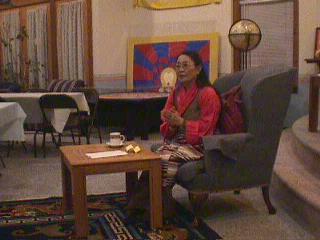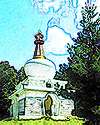Saturday
March 29, 2003 at 7.00 P.M.
Book signing
after the talk
Suggested donation
$15.00 ($12.00 seniors/students/TCC members)
 |
|
Dagmola Speaking about Tibet |
Lady Dagmola
Kusho, known by her friends as Dagmola, was born in Eastern Tibet.
Raised in a loving family of moderate affluence, her way of life
and education were pervaded by the spirit of Buddhism. In a society
in which most education was of a religious nature, available
chiefly to monks, she had the unusual good fortune to receive
a fine education from early age.
Dagmola's childhood
came to a swift end. As a very young woman she went on pilgrimage
from Kham, her homeland, to Sakya, the headquarters of one of
the four major orders of Tibetan Buddhism. She was introduced
to the politics of the Sakya ecclesistical hierarchy and she
was eagerly courted by a young religious nobleman of the Phuntshog
Palace who was being prepared to become the Head Lama of the
Sakya Order, H.H. Jigdal Dagchen Sakya. as a result of her marriage
she accepted the heavy burden of entering the ranks of Tibetan
nobility and of representing the tradition of this spiritual
lineage.
While the young
Dagmola accustomed herself to her new way of life, the freedom
of the Tibetan people began to be eroded by the infiltration
of Chinese Communists into Eastern Tibet. Before long, open hostilities
between the communists and the Tibetans became more prevelent,
and the Chinese responded with increased oppression and flagrant
disrespect for the native culture. The carefree days of Dagmola's
youth had now vanished.
Upon returning
to Central Tibet, Dagmola witnessed the severe oppression, deceit,
and manipulation the communists perpetrated upon her people.
As violence erupted in Lhasa, where she and her family were visiting,
they were forced to flee for their lives. Optimistic like many
other Tibetans that they would return home once the hostilities
had subsided, they fled south, but as the received reports of
the growing violence in the Tibetan capitol, these hopes vanished.
Enduring extreme hardship and fear in their flight from Tibet,
her family frequently relied on prayer for their safetly and
looked to divinations and omens to guide them to freedom. Even
in such dire circumstances her family displayed a resilience
and courage common among the Tibetan refugees. With an abiding
faith in the Buddha, they opened themselves in trust to an unkown
future which presented itself in an offer to Ven. Jigdal Dagchen
Sakya to come to the United States to collaborate in research
at the University of Washington.
During the
years since their arrival in the United States, Dagmola and her
husband have established a thriving Tibetan cultural center and
monastery in Seattle, Washington. In the meantime, Dagmola had
quietly devoted herself inwardly to her spiritual practice under
the guidance of her revered uncle, the late H.E. Deshung Rinpoche.
Outwardly she has selflessly devoted herself to bringing up her
five sons and assisting her husband in his many religious activities.
H.E. Deshung
Rinpoche had encouraged Dagmola to begin teaching Buddhism and
grating empowerments. Thus, she is authorized to accept the role
of Lama by one of the foremost Tibetan Buddhist masters of the
Sakya Order.



